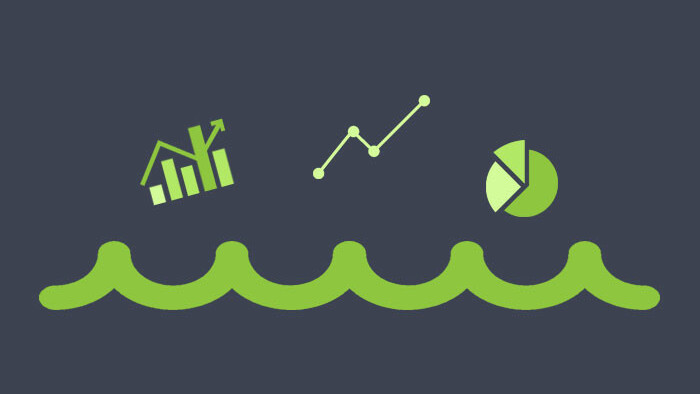
Lauren deLisa Coleman is a digi-culture trend analyst specializing in the convergence of popular culture, emerging tech and the impact on business and governance. This post originally appeared on the Geckoboard blog.
For a job title that barely existed three years ago, the role of a data scientist and the data-driven strategies they develop have become crucial tools for today’s marketing executives. In fact, according to a recent study by KPMG, more that half of the CFOs and CIOs polled said that big data was drastically changing their business strategies.
We’re swimming in a sea full of data. The key is how to turn it into useable information.
Whether we’re feeling outrage or having a LOL, it’s through storytelling and sentiment that brands drive engagement; understanding how this works can prove even more complex than analysing the numbers. Companies, both large and small, are recognising the importance of adopting both elements.
In a 2014 Marketing Trends Survey, marketers ranked sentiment as the third-most valuable element to be extracted within data-driven strategies, after web behaviour and browsing behaviour.
So, how do you crack the code of balancing data and emotion within a brand strategy today, while also meeting the challenges of tomorrow?
The Holy Grail of marketing
Wired magazine recently reported that, despite significant advances in computer-facilitated learning, it is still difficult for these machines to understand and process natural language, automate sentiment analysis, or determine ambiguous context.
However, as Onoly’s Emad Hasan, previously analytics product manager at PayPal, points out:
“Given the progress of technologies such as Natural Language Processing (NLP) and social media, brands have the opportunity to pinpoint levers that are most relevant to them today. Companies like Quantifind [an analytics platform forecasting consumer actions in the real world] are leading the way by using complex signal processing and Neuro-Linguistic Programming.”
Being able to access and decipher language, and therefore emotion, has become the holy grail for today’s marketing executives. As Matt Wallaert, Behavioral Scientist at Bing, explains, “we now know emotions are a huge factor in how people make decisions– not just what they think, but how to think, which is the key distinction that marketers are just now catching up to.”
Compare it to the Mad Men era of advertising, when emotions were seen in more of a black and white sense: if you could make people happy and show them a Coke, they’d love Coke. We now understand that emotions work more like perceptual filters, tying in with our daily habits and influencing our decisions.
And as the ability to analyse data has grown more and more fine-tuned this has become the hottest area of clinical research, whether we as consumers are aware of it or not.
Brands have feelings, too
Planning for, executing, and evaluating a multi-faceted marketing strategy is a difficult task; its part art and part science, although some companies are looking to tilt that balance to the latter.
“This new reality has made the consumer-brand relationships even more challenging,” notes Marcelo Ballestiero, CEO of Libring, one of the new generation of companies bringing leverageable perspective to big data.
“Everything is global, online and real-time. Consumers connect with brands through an ocean of new channels that generate daily an amount of data that leaves marketers struggling to understand what works or doesn’t work,” he says.”
Some analytics tools in the market can now easily process this huge volume of data and model consumers’ behaviour using mathematical algorithms to predict customers lifetime value, estimate their likelihood of purchasing in a near future and maximize total return on marketing investment.
Analytics can also jump silos of common information within corporations and extract insights on most relevant attributes of customers, automatically clustering them with a micro-segmentation approach. This is the answer that marketers look for to allow them to generate campaigns with greater confidence.
“But,” adds Ballestiero, “it has to be in a company’s DNA to operate this way. It’s not something you can just layer on and hope for the best.”
The popular active-wear brand Under Armour is committed to such a goal, particularly with its recently acquired fitness tracking app, MapMyFitness. Chris Glodé, General Manager at MapMyFitness, says, “While we are committed to a data-driven approach, at the same time we are sensitive to the emotional connection we need to make with our audience to truly tell our story.
“While very much data-driven in terms of metrics and optimizations, it’s the creative nature of our campaigns that tap into the emotions of the fitness enthusiast and motivate them to be more active.”
Data for everyone
The big data-emotion connection are far from being the sole purview of the big players. Savvy startups are likewise gaining attention by being mindful of both data and emotion in growing their audiences.
Barkbox, an e-commerce company launched in 2011 specialising in high-quality products for dogs, boast an astonishing 95percent customer-retention rate.
“We’re conscious of infusing the sentiment around our brand – the love of all things dog– in everything we do,” says Chris O’Brien, Communications Director for the company. “And part of that is knowing that a particular data set will not tell us everything we need to know about our customers’ emotional responses,”
He added, ‘This type of measurement is evolving. For instance, we have on-page chat that lets us get immediate feedback, NPS surveys to score customer satisfaction and cancellation surveys to understand why they canceled and so on.”
From an advertising agency’s perspective, the challenge lies in getting that elusive emotion-data balance right, over and over again. According to Leigh George, Vice President of Social at Ogilvy, the immediacy and reach of social media have pushed emotion and storytelling front and center of their strategies.
“Social media has forced brands to adopt a human-to-human approach to marketing, so that relationship building is emphasized over corporate anonymity and the hard sale,” she says.
“Our approach to research and data has had to move away from numbers-driven, demographic buckets to include psychographics and an awareness of people’s personal beliefs and values.”
It’s a battlefield out there
The way in which brands approach this new terrain does not come without potential landmines. According to O’Brien, “A lot of brands are too near-sighted and worried about immediate sales to see the value in all this.”
The result? Many companies find themselves having to play catch up, or simply missing opportunities and losing gradual market share’.
For those companies successfully paying attention to both the quantitative and qualitative, there are also caveats. Privacy concerns around data gathering and emotion mining will surely grow. Facebook recently experienced intense backlash from the public when it was revealed that the social network conducted a controversial ‘emotion contagion’ experiment with user data, failing to follow ethical protocols.
As consumers become more aware, and more wary of, the way companies are probing their own thoughts and passions, major issues and battles loom.
“I think there is a very real danger that psychology becomes an arms race between marketers and consumers,” says Wallaert. “We have a limited amount of cognitive attention that we can devote to the world in a day, and as more brands are clamor for it, they each get a smaller piece of the pie.
“If we don’t reverse that trend, we risk fragmenting consumers among so many cognitive experiences that the switching costs between them actually outweigh our time spent in them.”
As the infancy that is the data-emotion mash-up begins to mature, even greater challenges lie ahead. In order to overcome these hurdles and keep up with the race, marketers need to focus on both quantitative and qualitative elements.
Likewise, the importance of having multi-disciplinary teams with talented data scientists and creatives will increase, as their roles become ever more intertwined.
Being all things… not
The consequence of this new digital era is the proliferation of consumers’ behavioural data. Back in the day when the points of contact with brands concentrated on very few channels, intuition-based decisions drove most of companies’ marketing strategies.
In this new world of marketing, where everything can be measured, monitored and analyzed, it’s about grabbing the right slice of an audience’s attentions. And so, it becomes increasingly critical to incorporate the right kind of metrics and the right analyses. As Ballestiero sums up:
“Marketing strategies without data analytics is like trying to make fire without oxygen. It is impossible.”
Read next: The emotional involvement behind social media interactions
Get the TNW newsletter
Get the most important tech news in your inbox each week.







